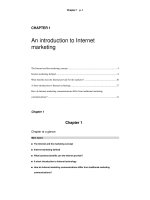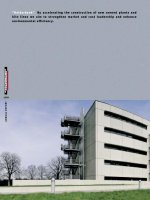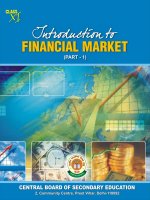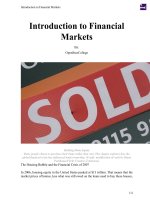final report cocoon introduction to laos market
Bạn đang xem bản rút gọn của tài liệu. Xem và tải ngay bản đầy đủ của tài liệu tại đây (1.34 MB, 19 trang )
<span class="text_page_counter">Trang 1</span><div class="page_container" data-page="1">
<b>COCOON INTRODUCTION TO LAOS MARKETTable of content:</b>
I) Introduction/Company overview.II) SWOT
III) Market Analysis
1. General of the Lao cosmetic market. 2. Cosmetics consumption in Lao.3. Cosmetics distribution system. 4. Types of cosmetics. 5. PEST analysis. 6. Competitors. IV) Recommendations V) Conclusion VI) Reference
</div><span class="text_page_counter">Trang 2</span><div class="page_container" data-page="2"><b>Members of Group 3:</b>
- Hoang Vu Phương Anh – QS170005- Huynh Thi Kieu Quanh – QS70006- Nguyen Tuyet Ngan – QS170044- Thai Binh Yen – QS170014- Nguyen Thanh Hieu – QS170019
<b>I) Introduction/Company overview:</b>
Loving nature and pursuing the spirit of beauty and environmental protection, you shoulddefinitely not ignore Cocoon - a cosmetic brand "made in Vietnam". Cocoon makes the most ofthe strength of indigenous natural ingredients and says no to animal testing.
<b>Vegan cosmetics are beauty products made solely from plant-based ingredients that havenot been tested on animals.</b>
Conventional cosmetics include many products that use ingredients of animal origin, such as:Beeswax, milk, snail mucus, silk, honey, wool fat (skin and wool), Albumin (a protein found inanimal serum), cholesterol (a fat found in animal cell membranes), gelatin.
<b>Brand meaning</b>
Here Cocoon means "cocoon", which nurtures small colorless worms until it turns into colorfulbutterflies. This is also the meaning for a new regeneration and nurturing of the skin and hair ofVietnamese people so that they can become more beautiful, confident and shine in their ownway. each person. The Creator has been extremely gracious when giving Vietnam an extremelyrich ecosystem from fruit trees to herbs and also not forgetting to include people who are always
</div><span class="text_page_counter">Trang 3</span><div class="page_container" data-page="3">reality is changing, with regard to health, people favor things belonging to nature rather thanproducts of chemistry and technology.
We have a starting point as people who always want to immerse themselves in discovering andlearning the special things in fruits, plants, herbs, herbs. Different vitamins, all nutrients areresearched and distilled to put in all Cocoon products in the most perfect way. For us, cosmeticsthat are allowed to be used on the skin must always be safe, effective and free of any plant-related ingredients. Because the original purpose is to promote skin health with the mostquintessential combination of nature. [1]
<b>History begin</b>
Launched in 2013, although the product was not very popular, at that time, many people wereknown for its benign natural products. But in the past 3 years, Cocoon suddenly returned andstormed the domestic cosmetics market, not only about the thoroughness in the product but alsocreating a highlight with the psychological words on the above. Packaging Products. Most of ussee, in the Vietnamese cosmetic market, Vietnamese brands are almost blurred in the eyes ofusers because of the confusion in quality compared to domestic products: Korea, Japan, ... On theother hand, Cocoon conquers customers thanks to the beautiful stories behind the process ofmaking each product and strict commitments on the safety of ingredients.
In 2021, Cocoon made a strong impression with a special collaboration with female rapperSuboi, to launch a limited edition Dak Lak coffee product that cleanses dead cells on the body -"Queen" Substance. This handshake has attracted the attention of young people. Recently,
</div><span class="text_page_counter">Trang 4</span><div class="page_container" data-page="4">at the Vietnam Bear Rescue Center.
Cocoon and Watsons have continuously accompanied each other (since 2019) in environmentalprotection and ecosystem improvement activities, including the program "Exchange old bottlesfor new products". Cocoon's bottle exchange points are located at Watsons stores, making thecustomer's environmental experience more convenient and faster. It is these diverse activities thathave created leverage, bringing Cocoon to a high position among Vietnamese brands present atWatsons.
Up to now, in 2023, not only Cocoon's products have been known to almost every region in thecountry but also imported to foreign countries. Promising a more complete development forVietnam's first pure natural cosmetic brand, which is extremely well received. At the same time,it marks the development of Vietnam in both wisdom and experience compared to othercountries.
Vegan Vietnamese cosmetics Cocoon hopes to become one of the leading Vietnamese brands ininspiring green living to Vietnamese youth with its own diverse vegan cosmetics fromVietnamese ingredients and community activities. Cocoon is also approved by Leaping Bunny -Cruelty Free International's commitment to not testing on animals, and has received a certificateof not testing on animals from the animal welfare organization PETA and certification. vegan byThe Vegan Society.
<b>Cocoon's achievements</b>
+ 08-2020: Cocoon received the certificate of "Animal test-free & Vegan" (not tested on animalsand vegan) from the global animal welfare organisation PETA.
</div><span class="text_page_counter">Trang 5</span><div class="page_container" data-page="5">world's oldest educational charity.
+ 11-2021 Cocoon received an award in the "Inspiring Brand" category at the Asia PacificEnterprise Awards (APEA 2021) .
<b>II) SWOT</b>
1. Opportunity:
- Vietnam and Thailand are two countries in ASEAN. In particular, both countries have signedthe AFTA Agreement. Under the AFTA agreement, member countries have agreed to reducetariffs on goods traded in the region, including cosmetics and personal care products. With thereduced tax rate, Cocoon's products will not be inflated too high in price, and remain at anaverage level for easy consumption.
- The beauty care market in Laos is expected to grow 3.21% annually (CAGR 2023-2027). Withsuch strong growth, this is an opportunity for Cocoon to break into this market. [2]
- Lao people tend to use cosmetics more and more in recent years. According to some marketreports, Laotians' access to cosmetic products has increased significantly, especially forinternational brands and high-end products. Laotians are increasingly interested in skin care andbeauty, which is reflected in the increased demand for cosmetic products, especially skin care,makeup and hair care products. With these needs in mind, Cocoon has all the products to meet.- Laos and Vietnam are both located in Southeast Asia, so the climate is almost similar.Therefore, the ingredients in Cocoon cosmetics are also suitable for Lao people.
- Laos cosmetics market is growing very fast, especially in natural and organic cosmeticproducts.
</div><span class="text_page_counter">Trang 6</span><div class="page_container" data-page="6">expand their operations.
- The Lao government is promoting production, business and investment activities, as well asstrengthening economic relations with countries in the region.
- The demand for cosmetics is increasing in Laos, especially for women.
- The cosmetic market in Laos has not been developed much, so there are many opportunities fornew businesses.
- Cosmetics can be produced from abundant natural ingredients in Laos.4. Weaknesses:
- Cocoon is still a relatively new brand, so it is not known by many foreign consumers.
</div><span class="text_page_counter">Trang 7</span><div class="page_container" data-page="7">- In addition, the Lao market advertises products mainly through celebrity reviews on their blogsor youtube. Therefore, Cocoon will have to spend a lot of money and effort to establishrelationships with famous people in this market so that more people know about the product.- The retail market in Laos is quite limited, so distribution channels for Cocoon cosmetics maynot be effective.
<b>III) Market Analysis:</b>
1. General of the Lao cosmetic market.
The cosmetics market in Laos is relatively small compared to other countries in the region, but itis growing steadily. The market is mainly driven by the growing demand for personal care andbeauty products among the country's young and growing middle class.
One of the big players in the Lao cosmetics market is Thailand's Siam Makro group, whichoperates several hypermarkets across the country. Other notable names include local brands suchas Lao Pong Phra and foreign brands such as L'Oreal and Nivea which are steadily and stronglyentering the Lao cosmetics market.
The market is highly competitive, with companies constantly introducing new products andpromotions to attract customers. There is also a growing trend towards natural and organicproducts, due to concerns about the potential health risks associated with certain chemicals foundin traditional cosmetics. It can be said that this is a problem that currently any cosmetic user isafraid. Each skin will have its own characteristics, so not all chemicals are suitable for differentskin types. Once again, Cocoon spoke strongly with its strength in Laos. Directly attacking thedesire that consumers want is Cocoon's vegan cosmetics.
</div><span class="text_page_counter">Trang 8</span><div class="page_container" data-page="8">infrastructure, limited distribution channels and lack of skilled labor. However, with thegovernment's focus on economic development and increasing foreign investment, the Laocosmetics market is expected to continue its upward trajectory in the coming years.
2. Cosmetics consumption in Laos:
Cosmetic consumption in Laos has steadily increased in recent years, especially among women.The growing interest in beauty products is driven by a number of factors, including increaseddisposable income, increased awareness of beauty and personal grooming, and the availability ofa wide variety of products. more products.
Although the cosmetics market in Laos is relatively small, it is expected to grow at a rapid rate inthe coming years. The country's young and urban population is becoming more fashion-conscious and increasingly looking for high-quality cosmetic products.
However, the market is still dominated by imported brands, very few cosmetic products areproduced domestically. This is an opportunity for domestic companies to penetrate the marketand provide products that meet the needs of Lao consumers.
In terms of distribution, cosmetics are mainly sold through beauty and personal care stores,supermarkets and online platforms. However, many consumers still prefer to buy their productsfrom traditional markets and small independent retailers.
In general, the cosmetics market in Laos has a lot of potential for growth, but there are still manychallenges to overcome, including lack of domestic production capacity, limited distributionchannels and the dominance of foreign brands. . However, with the right strategies and
</div><span class="text_page_counter">Trang 9</span><div class="page_container" data-page="9">3. The cosmetics distribution system
- The cosmetic distribution system in Laos is still developing and relatively fragmentedcompared to more mature markets. There are several channels through which cosmetic productsare distributed, including:
- Traditional retail stores: Cosmetic products are usually sold at traditional retail stores such assupermarkets, pharmacies and convenience stores. These stores offer a wide range of productsfrom international and local brands.
- Specialized stores: There are also specialized stores that focus on cosmetics and skin careproducts. These stores offer a wider range of products and are more likely to sell premium orpremium brands.
- Online platform: With the growth of e-commerce, many cosmetic products are now sold online.This includes both domestic and international e-commerce platforms, as well as social mediamarketplaces like Facebook and Instagram.
- Direct selling: Direct selling is also popular in Laos, especially for products such as skin careand beauty supplements. Companies can use dealer networks to sell products directly toconsumers.
- Parallel imports: Due to the relatively small market size and limited distribution channels,parallel imports are also common in Laos. This refers to products imported through unofficialchannels or from neighboring countries, rather than directly from the brand owner.
</div><span class="text_page_counter">Trang 10</span><div class="page_container" data-page="10">challenges, especially in rural areas. Many companies rely on third-party logistics providers tomanage their supply chains and distribution networks.
4. Types of cosmetics.
Laos does not have many famous cosmetic lines that are widely recognized internationally.However, there are some local brands that are gaining popularity in Laos. Here are someexamples:
- Lao Silk Beauty: This brand produces handmade cosmetic and skin care products usingtraditional Lao silk as the main ingredient.
- Naphavong Beauty: This brand offers a wide range of natural skin care products made withingredients sourced from the countryside of Laos.
- Lao Herbal Beauty: This brand uses local herbs and natural ingredients to create skin careproducts and cosmetics that are gentle on the skin.
- Lao P.D.R Beauty: This brand produces high-quality skin care and cosmetic products usinglocally sourced ingredients.
- It is worth noting that these brands may not be widely available outside of Laos, but they aregaining popularity within the country. In addition, international cosmetic brands such as L'Oreal,Maybelline and Revlon are also present at some retail stores in Laos.
5. PEST analysisPolitics:
- Laos is a politically stable country and rarely has major political conflicts. Most of theseconflicts were controlled and ensured political stability in Laos. This is a great advantage to
</div><span class="text_page_counter">Trang 11</span><div class="page_container" data-page="11">the import.
- Vietnam is a major partner of Laos after Thailand and China, especially in the past few years,the friendly relationship between the two countries has also made great strides. In order to showsolidarity and support each other for mutual development, Vietnam and Laos have signed manytrade agreements with many preferential tariffs, creating favorable conditions to promote tradeactivities between the two countries. Therefore, the export potential is also high. [3]
- Since joining ASEAN, ASEAN countries will enjoy preferential tax rates. However, importedgoods are usually subject to two types of taxes, namely import tax and value added tax (VAT).Import duties are calculated based on the import tax rate multiplied by the CIF value of thegoods (the price includes the value of the goods, insurance and freight charges). VAT will then becalculated based on the full CIF value and import tax on the goods. Goods imported for thepurpose of re-export will normally be exempt from import duties and VAT. Under newregulations issued in December 2021, Laos' standard VAT rate is reduced from 10% to 7%. [4]- Laos has regulations on packaging and labeling for imported goods, especially consumerproducts such as food, cosmetics, drugs, household appliances, clothing and footwear. Theseregulations are enshrined in the Commercial Law 2017 and the government's executive decreesand decisions. Packaging and labeling requirements for imports into Laos include:
+ Packaging: Imported goods must be properly packed and transported to ensure product safetyduring transportation and storage. Packaging must meet the safety and hygiene standards setforth by the regulatory authorities.
+ Label: Imported products must have complete and accurate labels to ensure that consumers can
</div>








